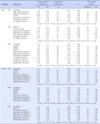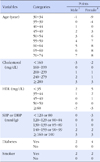Abstract
Purpose
This study was to investigate factors influencing the Framingham risk score-Coronary heart disease (FRS-CHD) according to gender and body mass index (BMI) of adults who participated in the 5th Korea National Health and Nutrition Examination Survey (KNHANES V-3).
Methods
This study used a cross-sectional design with secondary analysis with KNHANES V-3. The FRS-CHD scores were measured with ages, sex, blood pressure, cholesterol, high density lipoprotein, smoking, and diabetes mellitus. With demographic characteristics, family history of ischemic heart disease, types (intensity) and days of physical activities, perceived stress, drinking, menopause (in female), and BMI scores were measured. The data were analyzed with descriptive statistics, Pearson's correlation coefficients, and multiple regressions.
Results
FRS-CHD was significantly associated with types (intensity) and days of physical activities, educational level, occupation, and marital status, explaining 19.1~76.8% of the variance in men. FRS-CHD was significantly associated with types (intensity) and days of physical activities, menopause, and education level, explaining 55.0~59.5% of the variance in women.
Figures and Tables
 | Figure 1Selection of subjects from the 5th Korean National Health and Nutrition Examination Survey 2012. |
Table 5
Adjusted Model Summary and Regression Coefficients in Male and Female

SE=Standard error; NW=normal body weight; OW=over-weight; OB=obesity; AUDIT=Alcohol use disorders identification test; MSED=Muscle strength exercise dummy; VPAD=Vigorous physical activity dummy; MPAD=Moderate physical activity dummy; FHCHDD=Family history of coronary heart disease dummy; SEE=Standard error of the estimate; D-W=Durbin-Watson.
References
1. Statistics Korea. The statistical result about cause of death at 2012 [Internet]. Seoul: Statistics Korea;2013. cited 2014 August 5. Available from: http://www.index.go.kr/potal/main/EachDtlPageDetail.do?idx_cd=1012.
2. Mendis S, Puska P, Norrving B, editors. Global Atlas on cardiovascular disease prevention and control. Geneva: World Health Organization in collaboration with the World Heart Federation and the World Stroke Organization;2011.
3. American Heart Association. Coronary artery/heart disease [Internet]. Dallas: American Heart Association;2014. cited 2014 August 5. Available from: http://www.heart.org/HEARTORG/Conditions/More/MyHeartandStrokeNews/Coronary-Artery-Disease---Coronary-Heart-Disease_UCM_436416_Article.jsp.
4. Framingham Heart Study. A project of the national heart, lung, and blood institute and Boston University [Internet]. Framingham: Framingham Heart Study;2014. cited 2014 June 14. Available form: http://www.framinghamheartstudy.org/about-fhs/history.php.
5. Wilson PW, D'Agostino RB, Levy D, Belanger AM, Silbershatz H, Kannel WB. Prediction of coronary heart disease using risk factor categories. Circulation. 1998; 97(18):1837–1847. http://dx.doi.org/10.1161/01.cir.97.18.1837.

6. Murray CJ, Lauer JA, Hutubessy RC, Niessen L, Tomijima N, Rodgers A, et al. Effectiveness and costs of intervention to lower systolic blood pressure and cholesterol: A global and regional analysis on reduction of cardiovascular-disease risk. Lancet. 2003; 361(9359):717–725. Cited by Choi EH, Seo JY. Framingham risk score by general characteristics and physical activity: Based on the 4th Korean national health and nutrition examination survey. Korean Public Health Research. 2011;37(1):85-96.
7. Framingham Heart Study. Risk score profile [Internet]. Framingham: Framingham Heart Study;2014. cited 2014 May 23. Available form: http://www.framinghamheartstudy.org/risk-functions/index.php.
8. Fletcher GF, Blair SN, Blumenthal J, Caspersen C, Chaitman B, Epstein S, et al. Statement on exercise: Benefits and recommendations for physical activity programs for all Americans. A statement for health professionals by the committee on exercise and cardiac rehabilitation of the council on clinical cardiology, American Heart Association. Circulation. 1996; 94(4):857–862. http://dx.doi.org/10.1161/01.cir.94.4.857.

9. Strath SJ, Swartz AM, Bassett DR Jr, O'Brien WL, King GA, Ainsworth BE. Evaluation of heart rate as a method for assessing moderate intensity physical activity. Med Sci Sports Exerc. 2000; 32:9 Suppl. S465–S470. http://dx.doi.org/10.1097/00005768-200009001-00005.

10. World Health Organization Western Pacific Region. Pacific physical activity guidelines for adults. Framework for accelerating the communication of physical activity guidelines [Internet]. World Health Organization Western Pacific Region: WHO;2008. cited 2014 January 13. Available from: http://www.who.int/dietphysicalactivity/publications/pacific_pa_guidelines.pdf.
11. Warburton DER, Katzmarzyk PT, Rhodes RE, Shephard RJ. Evidence-informed physical activity guidelines for Canadian adults. Can J Public Health. 2007; 98:Suppl 2. S16–S68. http://dx.doi.org/10.1139/H07-123.
12. Maeda S, Miyauchi T, Goto K, Matsuda M. Alteration of plasma endothelin-1 by exercise at intensities lower and higher than ventilatory threshold. J Appl Physiol (1985). 1994; 77(3):1399–1402.

13. Maeda S, Miyauchi T, Sakane M, Saito M, Maki S, Goto K, et al. Does endothelin-1 participate in the exercise-induced changes of blood flow distribution of muscles in humans. J Appl Physiol (1985). 1997; 82(4):1107–1111.

14. Whitlock G, Lewington S, Sherliker P, Clarke R, Emberson J, Halsey J, et al. Body-mass index and cause-specific mortality in 900,000 adults: Collaborative analyses of 57 prospective studies. Lancet. 2009; 373(9669):1083–1096. http://dx.doi.org/10.1016/s0140-6736(09)60318-4.
15. Gelber RP, Gaziano JM, Orav EJ, Manson JE, Buring JE, Kurth T. Measures of obesity and cardiovascular risk among men and women. J Am Coll Cardiol. 2008; 52(8):605–615. http://dx.doi.org/10.1016/j.jacc.2008.03.066.

16. Arnlov J, Ingelsson E, Sundstrom J, Lind L. Impact of body mass index and the metabolic syndrome on the risk of cardiovascular disease and death in middle-aged men. Circulation. 2010; 121(2):230–236. http://dx.doi.org/10.1161/circulationaha.109.887521.

17. Zheng W, McLerran DF, Rolland B, Zhang X, Inoue M, Matsuo K, et al. Association between body-mass index and risk of death in more than 1 million Asians. N Engl J Med. 2010; 364(8):719–729. http://dx.doi.org/10.1056/nejmoa1010679.
18. Romero-Corral A, Montori VM, Somers VK, Korinek J, Thomas RJ, Allison TG, et al. Association of bodyweight with total mortality and with cardiovascular events in coronary artery disease: A systematic review of cohort studies. Lancet. 2006; 368(9536):666–678. http://dx.doi.org/10.1016/s0140-6736(06)69251-9.

19. Choi MC, Song YH, Lee SY, Woo JT. Framingham risk scores by occupational group: Based on the 3rd Korean national health and nutrition examination survey. Korean J Occup Environ Med. 2009; 21(1):63–75.

20. Yang IS, Choi DH, Kang YH. The awareness of cardiovascular risk factors and its correlates in patients with coronary artery diseases. J Korean Acad Adult Nurs. 2010; 22(5):499–508.
21. Bigert C, Gustavsson P, Hallqvist J, Hogstedt C, Lewne M, Plato N, et al. Myocardial infarction among professional drivers. Epidemiology. 2003; 14(3):333–339. http://dx.doi.org/10.1097/01.EDE.0000057141.91012.80.

22. Kim KA, Kim JS, Kim MS. Predictors of coronary heart disease risk in healthy men and women. J Korean Acad Nurs. 2007; 37(7):1039–1048.

23. Gill T. Epidemiology and health impact of obesity: An Asia Pacific perspective. Asia Pac J Clin Nutr. 2006; 15:Suppl. 3–14.
24. Smart N, Marwick TH. Exercise training for patients with heart failure: A systematic review of factors that improve mortality and morbidity. Am J Med. 2004; 116(10):693–706. http://dx.doi.org/10.1016/j.amjmed.2003.11.033.

25. Choi EH, Seo JY. Framingham risk score by general characteristics and physical activity: Based on the 4th Korean national health and nutrition examination survey. Korean Public Health Res. 2011; 37(1):85–96.
26. Park SH, Kang YH, Park HY. Alcohol consumption and the coronary heart disease-related risk factors in Korean adults: The third Korea National Health and Nutrition Examination Survey (KNHANES III), 2005. Korean J Nutr. 2008; 41(3):232–241.
27. Agarwal DP. Cardioprotective effects of light-moderate consumption of alcohol: A review of putative mechanisms. Alcohol Alcohol. 2002; 37(5):409–415. Cited by Park SH, Kang YH, Park HY. Alcohol consumption and the coronary heart disease- Related risk factors in Korean adults: The third Korea National Health and Nutrition Examination Survey (KNHANES III), 2005. Journal of Nutrition and Health. 2008;41(3):232-241.





 PDF
PDF ePub
ePub Citation
Citation Print
Print






 XML Download
XML Download